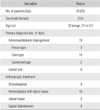1. Dobbs MB, Gordon JE, Luhmann SJ, Szymanski DA, Schoenecker PL. Surgical correction of the snapping iliopsoas tendon in adolescents. J Bone Joint Surg Am. 2002; 84(3):420–424.
2. Ward WT, Fleisch ID, Ganz R. Anatomy of the iliocapsularis muscle: relevance to surgery of the hip. Clin Orthop Relat Res. 2000; (374):278–285.
3. Taher RT, Power RA. Iliopsoas tendon dysfunction as a cause of pain after total hip arthroplasty relieved by surgical release. J Arthroplasty. 2003; 18(3):387–388.
4. Tanzer M, Noiseux N. Osseous abnormalities and early osteoarthritis: the role of hip impingement. Clin Orthop Relat Res. 2004; (429):170–177.
5. Byrd JW. Evaluation and management of the snapping iliopsoas tendon. Instr Course Lect. 2006; 55:347–355.
6. Clarke NM, Taylor G. Differing approaches to the surgical correction of snapping hip. J Bone Joint Surg Am. 2003; 85(2):383–384.
7. Jacobson T, Allen WC. Surgical correction of the snapping iliopsoas tendon. Am J Sports Med. 1990; 18(5):470–474.
8. Hoskins JS, Burd TA, Allen WC. Surgical correction of internal coxa saltans: a 20-year consecutive study. Am J Sports Med. 2004; 32(4):998–1001.
9. Contreras ME, Dani WS, Endges WK, De Araujo LC, Berral FJ. Arthroscopic treatment of the snapping iliopsoas tendon through the central compartment of the hip: a pilot study. J Bone Joint Surg Br. 2010; 92(6):777–780.
10. Ilizaliturri VM Jr, Martinez-Escalante FA, Chaidez PA, Camacho-Galindo J. Endoscopic iliotibial band release for external snapping hip syndrome. Arthroscopy. 2006; 22(5):505–510.
11. Ilizaliturri VM Jr, Chaidez C, Villegas P, Briseno A, Camacho-Galindo J. Prospective randomized study of 2 different techniques for endoscopic iliopsoas tendon release in the treatment of internal snapping hip syndrome. Arthroscopy. 2009; 25(2):159–163.
12. Domb BG, Shindle MK, McArthur B, Voos JE, Magennis EM, Kelly BT. Iliopsoas impingement: a newly identified cause of labral pathology in the hip. HSS J. 2011; 7(2):145–150.
13. Shu B, Safran MR. Case report: bifid iliopsoas tendon causing refractory internal snapping hip. Clin Orthop Relat Res. 2011; 469(1):289–293.
14. Harris WH. Traumatic arthritis of the hip after dislocation and acetabular fractures: treatment by mold arthroplasty: an end-result study using a new method of result evaluation. J Bone Joint Surg Am. 1969; 51(4):737–755.
15. Tonnis D. Normal values of the hip joint for the evaluation of X-rays in children and adults. Clin Orthop Relat Res. 1976; (119):39–47.
16. Outerbridge RE. The etiology of chondromalacia patellae. J Bone Joint Surg Br. 1961; 43(4):752–757.
17. Fabricant PD, Bedi A, De La Torre K, Kelly BT. Clinical outcomes after arthroscopic psoas lengthening: the effect of femoral version. Arthroscopy. 2012; 28(7):965–971.
18. Flanum ME, Keene JS, Blankenbaker DG, Desmet AA. Arthroscopic treatment of the painful "internal" snapping hip: results of a new endoscopic technique and imaging protocol. Am J Sports Med. 2007; 35(5):770–779.
19. Khan M, Adamich J, Simunovic N, Philippon MJ, Bhandari M, Ayeni OR. Surgical management of internal snapping hip syndrome: a systematic review evaluating open and arthroscopic approaches. Arthroscopy. 2013; 29(5):942–948.
20. McCormick F, Kleweno CP, Kim YJ, Martin SD. Vascular safe zones in hip arthroscopy. Am J Sports Med. 2011; 39:Suppl. 64S–71S.
 ). The surgery was completed with a thorough inspection of the peripheral compartment with care to note the presence of a cam lesion or capsular-sided labral abnormality. The operation was completed by joint lavage and injection with a local anesthetic. Postoperatively, all patients followed a standardized rehabilitation program.
). The surgery was completed with a thorough inspection of the peripheral compartment with care to note the presence of a cam lesion or capsular-sided labral abnormality. The operation was completed by joint lavage and injection with a local anesthetic. Postoperatively, all patients followed a standardized rehabilitation program.



 PDF
PDF ePub
ePub Citation
Citation Print
Print






 XML Download
XML Download